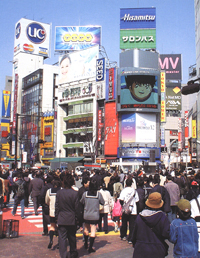japan
Japan is the fourth largest island state of the world after Indonesia, Madagascar and Papua New Guinea.
It lies in the Pacific off the coasts of Russia and South Korea and contain the four main islands of Hokkaido, Honshu,
Shikoku and Kyu-shu as well as over 3,000 smaller islands.
When Japan is seen from abroad, inevitably people are both amazed an shocked by scenes dominated by the clamour of busy,
bustling Tokyo. The capital is not only big, with its more than 20 million people coming and going, but also inscrutable
in the eyes of non-Japanese. The city is packed with signboards, posters, and light boxes that can be hardly understood.
Moreover, the physical distance between western countries and islands of Japan makes it hard for people to come and see
what the country is about with their own eyes. But the city of Tokyo an Japan itself is not only that. Today Japan is a
country of contrasts, a place wheree everything occurs simultaneously .
Japanese culture is originally based on the simplicity of things, whether in the way you express your feeling or serve the
food.

The art in the Japanese culture has a strong presence, what is also known over a long distance in the west. (Europe)
In the last decades of the 19th century many European artist circles were filled with enthusiasm by the Japanese
products with the most sophisticated cultural esthetics. Mostly varnish, ceramic and putting walls, which were painted,
are imported to Europe.
The strong form consciousness, which is noticeable in many areas of the culture, also gives the art its typical character.
influences
Nature carries the most important role in the Japanese art. The seasons, the day room between the sea and the mountains,
the humid climate, the typhoons, the earthquakes promoted the respect for the nature, which people are delivered.


